First, let’s walk the fence by saying that Atlassian Connect and Forge are excellent software development tools. “Best” is somewhat arbitrary and depends on which developer makes the call. There are benefits to Forge that make it superior to Connect in several ways. Here, we’re going to dig into why we’re migrating all our clients’ apps away from Connect to Forge.
As a developer, I’ve appreciated the “run anywhere” flexibility that Connect affords me. You can write in any language, making software engineering so accessible. Control over data format and access includes what data is stored and where enables you to maximize interconnectedness with other apps. That’s all good because you need to synchronize development, staging, and production server environments to accurately simulate how testing will parlay in a real-world scenario.
But then your test reveals that the database is now working slowly calling up the data – and we all know how little patience end-users have. It’s all about speed and performance for them. So, you start analyzing why it’s running so slowly. And then you discover it’s not your code at all. Instead, it’s the settings that were preconfigured in the database. Your next unwelcome assignment is to become a database administrator (DBA), which requires you to comb through massive database manuals to figure out which setting you need to adjust to boost the performance of your new code.
Forge puts all the logs in one place
Once you’ve read enough to be mildly proficient in database administration, you begin the tedious task of reviewing the logs for all micro-services. Naturally, there is more than one log for more than one client: you must inspect them all! To make your life easier, you need to develop a solution to identify records for that client, which means you are reinventing the wheel. You’re required to collect all the logs in a single place to analyze them with a solution such as ELK. If you don’t know how to administer ELK, you’ll need to learn how to check for errors. One by one, you’ll find errors, but it’s tedious and requires a few extra steps before you can even begin fixing mistakes.
Forge made our lives a lot better by combining all logs into one place with an interface that makes it accessible, and the search logic is sound – which makes you efficient. Here’s another perk that makes Forge fabulous – Atlassian pays for all those virtual servers and databases that you previously loaded your app infrastructure into, so you’re gaining cost efficiencies and time-based ones. And you no longer need to remember to back up the database of your clients because Forge does that, too. The difference from Connect to Forge is a massive leap in efficiency because of how they’ve designed their cloud.
Forge solves the continuous uptime challenge
Like everything else, as impressive as Atlassian Connect is, it has a few aspects that take a chip out of your enthusiasm for the platform. For example, security is less than optimal because one entry-point is all you need to access the complete Jira/Confluence development environment at an enterprise customer. More specifically, for all clients who install that app, in the absence of essential security mechanisms encoded to protect from a breach, clients can penetrate that app to access other clients’ data. Nobody wants to be that developer who unknowingly creates the portal that enables a breach in client data. Forge removes that risk of breach by pre-fabricating all the essential security mechanisms required to protect that entry-point. Developers from one organization no longer get the “keys to the kingdom” to snoop around another organization’s data with these new security provisions in Forge.
Uptime makes you wholly dependent on everybody else to ensure that the web services you tied into your workflow are up and running the moment it’s needed, and if they are not, everything goes down. That’s another plus point with Atlassian Forge – because they’ve taken on the responsibility of module (aka app) management, they’ve essentially also taken on the responsibility of continuous uptime. And that’s an incredible perk.
Forge handles authorization for you
However, accessibility was an afterthought. Each of us must go through endless hoops to secure “trusted supplier” status so that we can store a customer’s data locally. That doesn’t sound all that bad – until you’re the one that needs a local instance of that data, yet you’re also the one that doesn’t have that approved badge you need. It’s painfully unproductive.
There are numerous examples of painful development. Oh, let me count the ways Atlassian authorization protocols are, by design, meant to thwart the efforts of the “bad actors” who are trying to breach client data. The challenge is that these authorization protocols designed by Atlassian are not static; they’re constantly changing, which requires you as the developer to make changes to your app regularly. Keeping up with all the protocol changes requires time and effort to implement. Forge zeroed in on efficiency improvements because they eliminated this effort from your task list. You no longer need to keep up with any authorization changes because Forge does it for you.
Forge enters the plus side of the equation and the upper right of Gartner’s magic quadrant. The vendor dependency is gone. Removed. No longer a problem. Atlassian solved that major hurdle by hosting everything on their cloud. It’s brilliant in its simplicity and has long legs regarding its impact on software engineering.
Forge increases speed and security
Forge almost takes the fun out of the frustration inherent in being a software developer. The added security and control take the guesswork out of sleuthing for vulnerabilities. Self-contained modules can be coded and registered for a single-purpose, dedicated function. That amplifies the potential of novel mix & match combinations that you now make with all the modules available. You’ll be able to code more modules with the new, faster, declarative language. Everything you need is on the shelf: it’s like a grab & goes party for developers. And it’s certainly better than any hackathon experience that I’ve ever had. A more robust DevOps toolchain with Forge gives you more precision and control in end-to-end management of whatever workflows and combinations you’re creating. Everything has been centralized into your DevOps toolchain, from creation through development and testing to deployment.
Forge lets you do what you want to do as a developer – which is to build apps, not infrastructure. The increased shareability of whatever you develop offers you more significant revenue potential. And the reduced maintenance? That gives you back time to invest in building new apps that can further enhance your portfolio and revenue potential. If you’re debating making the switch from Connect to Forge – don’t. Just do it.



